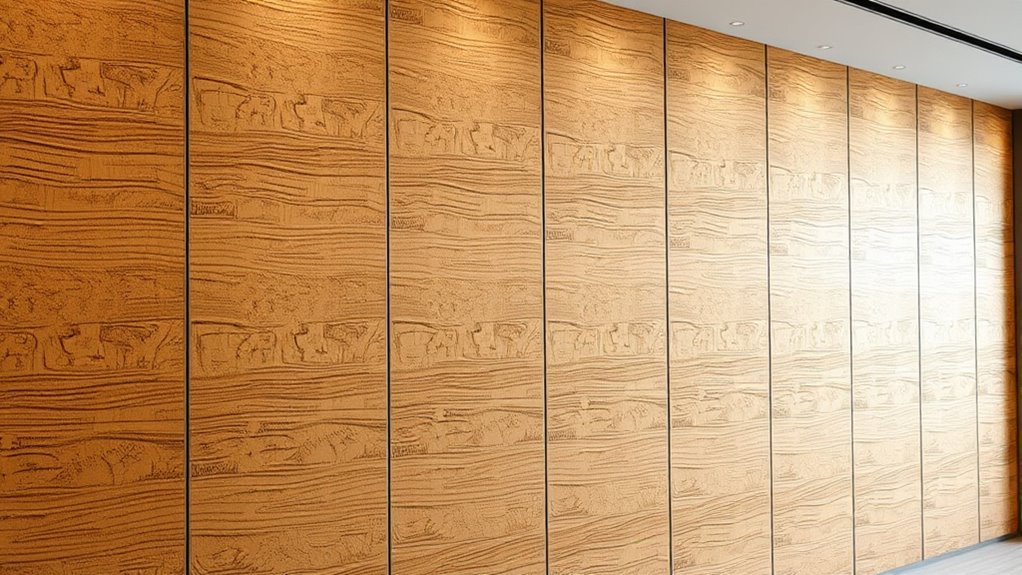Cork wall panels are shaping up to be a key component in future green décor due to their eco-friendly, sustainable qualities and health benefits. Made from renewable cork oak trees, they support long-term resource management and help reduce carbon footprints through carbon sequestration. Their versatility, insulating properties, and natural design appeal make them ideal for eco-conscious spaces. If you stay with us, you’ll discover how cork’s innovations and environmental benefits are transforming interior design into a greener future.
Key Takeaways
- Cork wall panels are made from renewable, biodegradable materials, supporting sustainable and eco-friendly interior design practices.
- Their excellent insulation and acoustic properties enhance energy efficiency, aligning with green building standards.
- The natural, hypoallergenic, and mold-resistant qualities promote healthier indoor environments.
- Cork’s ability to sequester carbon dioxide contributes to climate change mitigation efforts.
- Innovations in manufacturing and design make cork panels versatile, durable, and increasingly popular in sustainable décor trends.
The Sustainable Advantages of Cork as a Wall Material
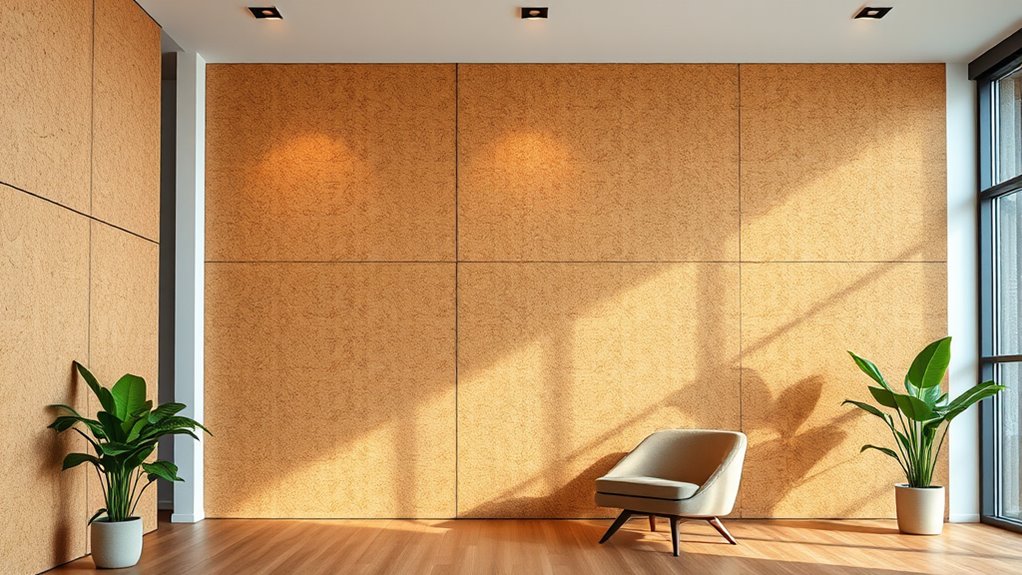
Cork wall panels offer significant environmental benefits because they are made from a renewable resource harvested sustainably from cork oak trees without harming them. This sustainability guarantees that cork can be harvested repeatedly without damaging the trees, supporting long-term resource management. Cork’s natural properties, including biodegradability and recyclability, further enhance its eco-friendliness by reducing waste and promoting circular use. Additionally, cork absorbs carbon dioxide, helping lower greenhouse gases in the atmosphere. Its cellular structure provides excellent thermal and acoustic insulation, decreasing energy use for heating and cooling. Properly maintaining cork panels can extend their lifespan, maximizing their durability and environmental impact. Moreover, cork’s ability to regulate humidity helps maintain indoor air quality and comfort. Choosing cork wall panels aligns with eco-conscious building practices, allowing you to create sustainable interiors that promote environmental health and reduce your carbon footprint. Overall, cork’s sustainability makes it an ideal choice for green architecture.
Environmental Impact and Carbon Sequestration Benefits
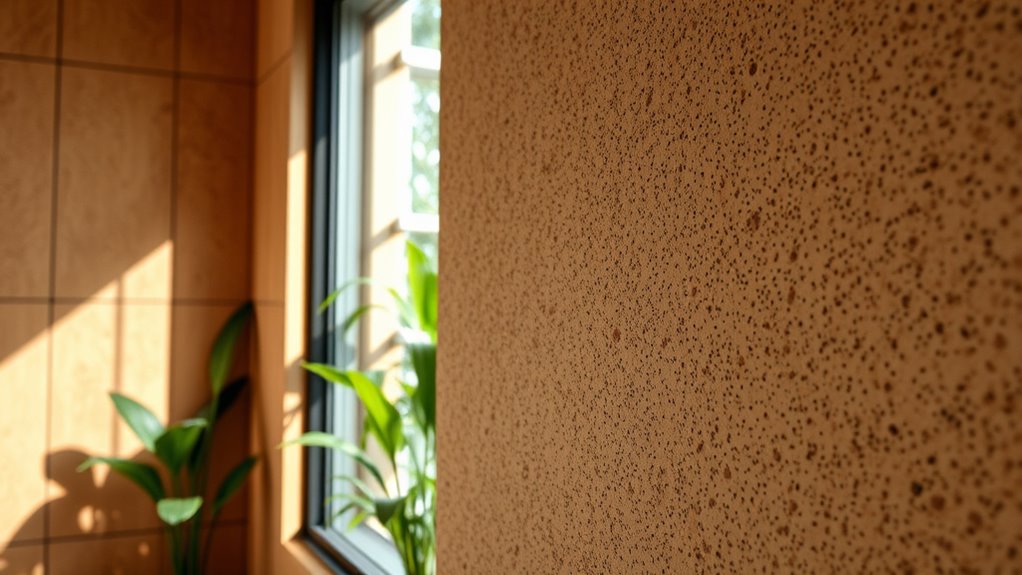
Because of its unique cellular structure, cork is an exceptionally effective carbon sink, absorbing up to five times more CO₂ than the tree emits during growth. This process, known as carbon sequestration, helps reduce greenhouse gases in the atmosphere. Each ton of harvested cork can sequester around 70 tons of CO₂, making cork a powerful tool in climate change mitigation. Cork forests serve as essential carbon reservoirs, naturally regenerating and maintaining their ability to store carbon over time. Additionally, cork’s renewable and biodegradable qualities ensure its environmental benefits last throughout its lifecycle. Incorporating cork wall panels into your space supports a sustainable lifestyle, actively lowering your overall carbon footprint and promoting environmentally friendly interior design.
Versatility in Design and Aesthetic Appeal
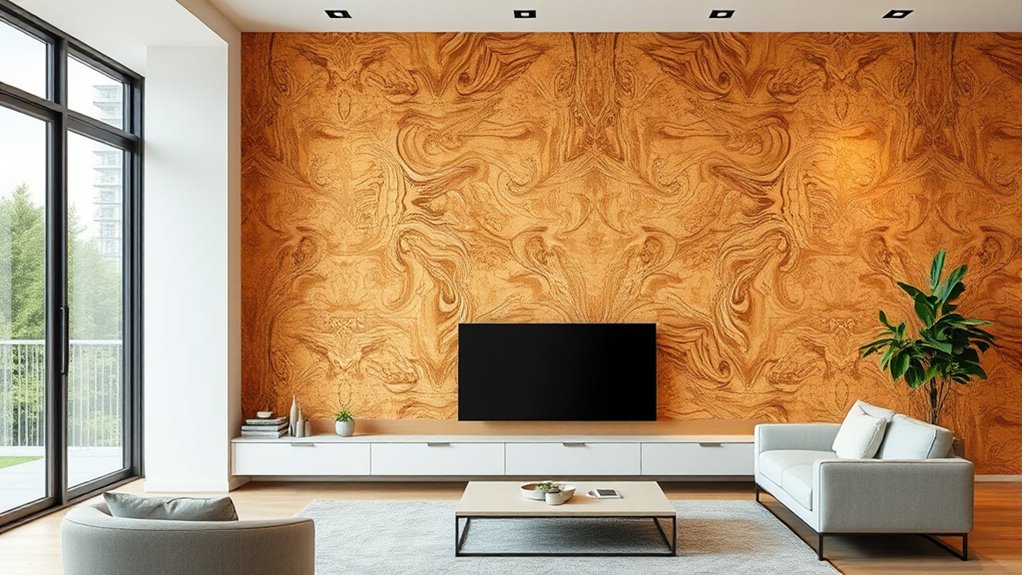
The natural appeal of cork wall panels extends beyond their environmental benefits, offering remarkable versatility in design and aesthetics. Their organic look and earthy tones enhance any space, complementing various interior design styles. Cork panels can mimic textures like marble, granite, and wood grains, providing diverse visual options. Their customizable sizes and shapes enable innovative architectural features and seamless integration into wall configurations. Using new finishes and veneers, you can achieve a modern or traditional look, all while benefiting from cork’s insulation properties. Cork oak, sourced from the cork tree in the Mediterranean region, naturally ages without deteriorating, thanks to its low conductivity of heat and resistance to mold and mildew. Whether used in cork flooring or decorative cork walls, natural cork’s volume and air content make it ideal for sustainable, stylish interiors. Additionally, understanding personal debt forgiveness bills can inform homeowners and designers about potential financial incentives related to eco-friendly renovations.
Thermal and Acoustic Performance in Interior Spaces
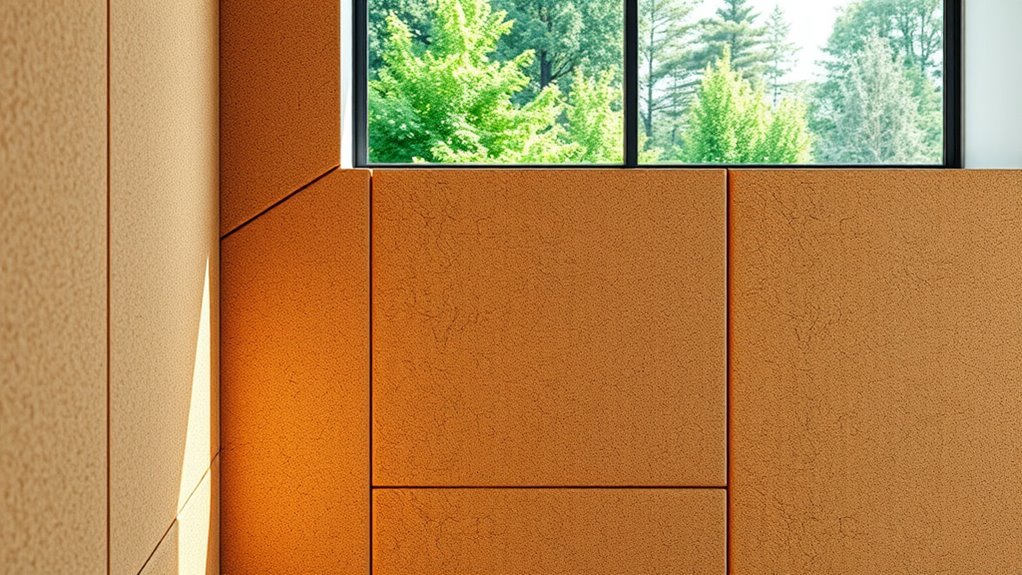
Cork wall panels excel at enhancing your space’s thermal comfort by reducing heat transfer, which can cut energy costs. They also absorb sound effectively, creating quieter environments and protecting your privacy. With their stable insulation properties, cork panels help maintain a consistent, comfortable atmosphere over time. Additionally, cork’s sustainable material contributes to environmentally friendly design choices. Incorporating natural materials not only boosts the eco-friendliness of your space but also adds a unique aesthetic appeal. Embracing creative practices like incorporating natural materials can further enhance your space’s aesthetic and functional qualities, making it a more eco-conscious environment.
Insulation and Comfort
Ever wondered how interior spaces can stay warm and quiet without relying heavily on energy-consuming systems? Cork wall panels excel at this. Their cellular honeycomb structure traps air, making cork a natural, efficient insulator for both temperature and sound. You’ll notice a more stable indoor climate, with less temperature fluctuation and improved comfort. Plus, cork’s low sound conduction properties cut down on noise transfer, creating a peaceful environment. To give you a clearer picture, here are some benefits:
- Excellent thermal insulation reducing heat transfer
- Natural soundproofing qualities
- Resilient cells maintain performance over time
- Eco-friendly, sustainable material
- Easy to install and maintain
Cork’s elasticity ensures lasting insulation, making it a smart choice for comfort and energy savings. Additionally, research into sound healing science suggests that sound vibrations can positively influence overall well-being, further enhancing the benefits of incorporating cork into interior spaces. Its durability and ability to maintain performance over time make it an even more attractive option for long-term interior design solutions. The cellular structure of cork also contributes to its long-term resilience and consistent insulating properties.
Furthermore, the inherent biodegradability of cork aligns with sustainable design principles, supporting eco-conscious building practices.
Noise Reduction Benefits
Installing cork wall panels can dramatically improve your space’s acoustic environment by reducing sound transmission and minimizing echoes. Their cellular honeycomb structure naturally absorbs sound waves, cutting noise between rooms by up to 50%, and creating a quieter, more comfortable atmosphere. Cork’s porous surface traps airborne particles and dampens vibrations, further enhancing sound quality and reducing indoor noise pollution. Additionally, cork’s thermal insulation helps stabilize room temperatures, which indirectly supports noise reduction. Whether in a home, office, or commercial space, cork panels effectively lower overall noise levels, making conversations clearer and reducing disruptions. Their combination of acoustic dampening and thermal benefits makes cork wall panels an innovative, eco-friendly solution for improving interior soundscapes while supporting sustainability.
Health and Safety Features of Cork Wall Panels
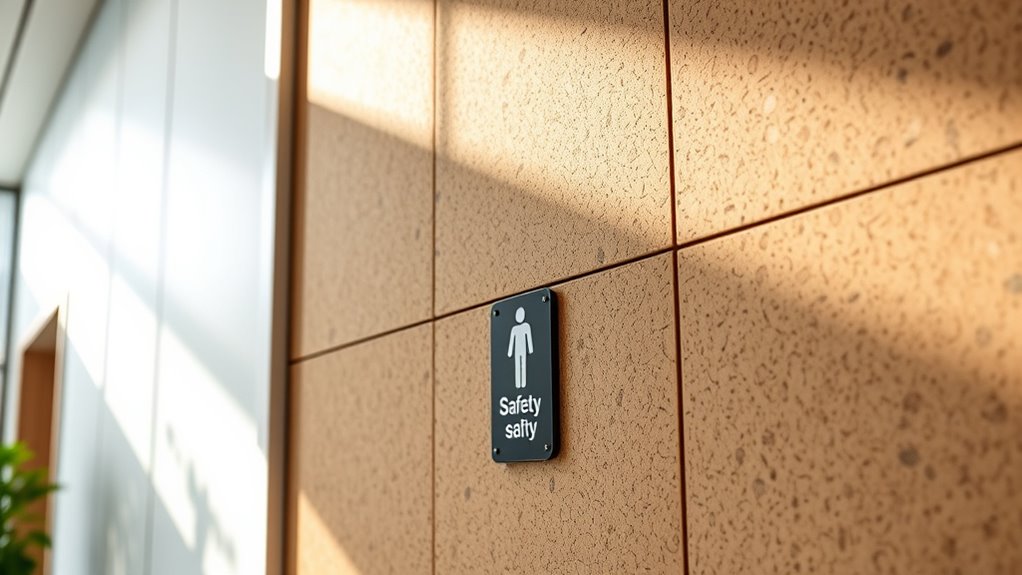
Cork wall panels offer several health and safety benefits that make them an excellent choice for your space. They are naturally hypoallergenic, resistant to mold, mildew, and dust mites, which helps improve indoor air quality. Additionally, cork’s fire-retardant properties and durability make certain a safer, long-lasting environment for everyone. Furthermore, the inspirational quotes associated with cork’s sustainability and natural origin can motivate environmentally conscious choices. Since cork is a natural material, it also contributes to better indoor air quality by reducing airborne allergens and pollutants. Moreover, the horsepower of electric dirt bikes indicates the potential for energy-efficient alternatives to traditional power sources, aligning with sustainable design principles. Understanding cheating and its impacts can also remind us of the importance of building trust and integrity in our living and working spaces, fostering healthier environments.
Non-Toxic and Hypoallergenic
Because cork wall panels are naturally hypoallergenic and non-toxic, they create a safer indoor environment by resisting dust, mold, and mildew. This helps improve your indoor air quality, making spaces healthier for everyone. Their non-toxic makeup means they emit no harmful volatile organic compounds (VOCs), reducing exposure to chemicals. Cork’s natural resistance to pests and allergens makes it ideal for allergy sufferers and sensitive individuals. Plus, they’re odor-free and dust-resistant, promoting a cleaner, safer space. Additionally, easy maintenance ensures they remain a long-lasting and hygienic choice for your home. Furthermore, their sustainable material contributes to eco-friendly building practices, making them a responsible choice for environmentally conscious consumers. Cork’s natural insulation properties also help in maintaining indoor temperature and reducing energy costs. Incorporating cork panels can also enhance your space’s acoustic performance, providing sound absorption and reducing noise pollution. Regular cleaning with gentle methods is key to preserving their benefits, which is why understanding air purifier maintenance can help keep indoor environments healthier. Consider these benefits:
- Resists dust, mold, and mildew
- Emits no harmful VOCs
- Naturally pest and allergen resistant
- Odor-free and dust-resistant
- Enhances overall indoor air quality
With cork, you’re choosing safer, healthier décor that’s good for you and the environment.
Fire-Resistant and Safe
Are you concerned about fire safety in your interior spaces? Cork wall panels naturally resist flames, burning without a flame and releasing non-toxic gases. This makes them a safer choice for homes and offices. The key is the suberin content in cork, which provides inherent flame resistance and prevents fire from spreading. Unlike synthetic options, cork doesn’t emit harmful fumes when exposed to heat or flames, helping maintain healthier indoor air. Plus, cork’s fire-resistant properties are tested and certified, ensuring you meet safety standards. Its natural, hypoallergenic, and odor-free qualities further contribute to a healthier environment. Additionally, AI-driven safety measures are continuously improving fire prevention and response strategies in building materials. With cork wall panels, you get a durable, eco-friendly solution that prioritizes safety without sacrificing style. Incorporating fire-resistant building materials like cork can also enhance overall safety protocols in residential and commercial spaces.
Mold and Mildew Resistance
If mold and mildew are concerns in your space, cork wall panels offer a natural defense. Their inherent properties make them resistant to moisture and microbial growth, helping you maintain a healthier environment. Cork contains suberin, a hydrophobic substance that blocks water infiltration and prevents mold from taking hold. Additionally, cork’s antimicrobial qualities inhibit mold spores and bacteria, promoting cleaner air. The honeycomb cellular structure creates an environment that’s unfriendly to mold development. Plus, cleaning and maintaining cork panels is easier, thanks to their resistance to mold and mildew.
Consider these benefits:
- Naturally resistant to mold and mildew
- Blocks water infiltration effectively
- Contains antimicrobial properties
- Unfavorable environment for mold growth
- Simplifies cleaning and maintenance
These features make cork wall panels a smart, safe choice for damp or humid spaces.
Ease of Installation and Maintenance Considerations
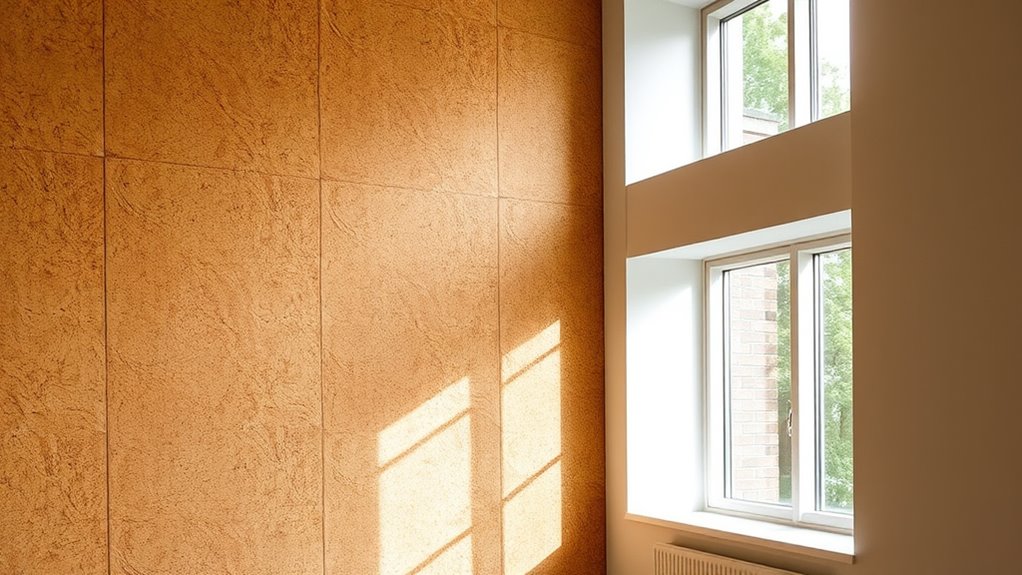
Cork wall panels are designed for straightforward installation, often utilizing simple mounting systems like adhesives or modular frames that save you time and reduce labor costs. Their lightweight nature, thanks to over 50% air volume, makes handling easy without heavy equipment. Once installed, they require minimal maintenance—regular dusting or sweeping keeps them looking fresh, while occasional damp cleaning preserves their appearance and functionality. Cork’s natural resilience and durability mean they can withstand daily wear and tear for decades, maintaining both their aesthetic and insulative properties. Plus, the eco-friendly maintenance routines—using fewer chemicals and less energy—support sustainable interior design. Overall, cork panels offer an easy, cost-effective, and environmentally conscious solution for both installation and ongoing upkeep.
Innovations in Cork Wall Panel Technologies
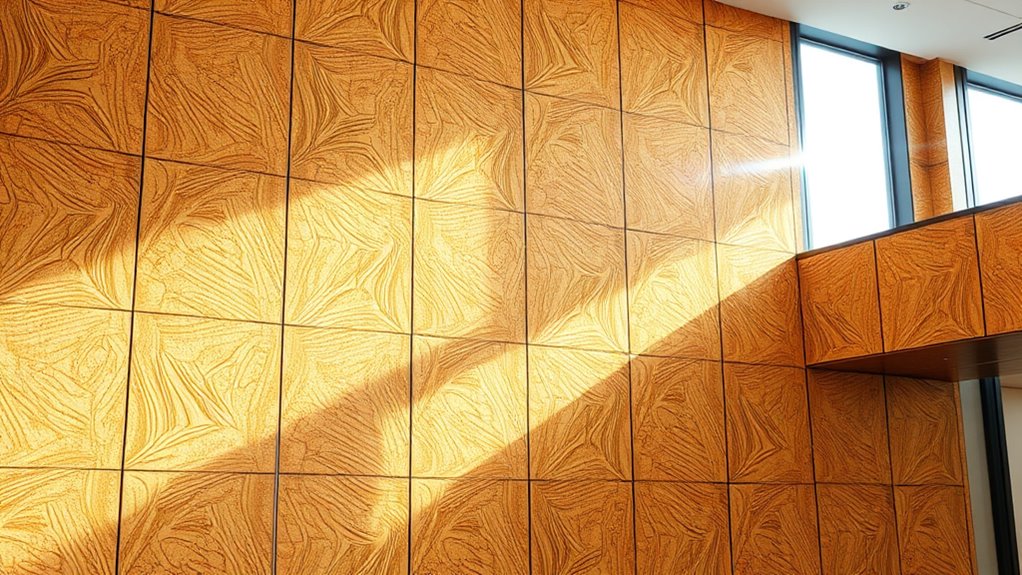
Have recent innovations transformed cork wall panels into more versatile and durable solutions? Absolutely. Advanced adhesives and binders now boost strength without sacrificing eco-friendliness. Large-format, seamless panels improve both looks and installation speed. Treated surfaces with stain, UV, and moisture-resistant coatings make cork suitable for various environments. Modular systems with integrated acoustic and thermal insulation add multi-functional benefits. Emerging manufacturing techniques produce lightweight, high-strength panels with enhanced fire-retardant and anti-microbial properties. These innovations allow you to enjoy durable, sustainable, and attractive cork wall coverings. They’re no longer just decorative but also practical. Whether for residential or commercial spaces, these technological advances expand cork’s potential as a future-proof, eco-friendly decor solution.
- Eco-friendly adhesives strengthen durability
- Large seamless panels boost aesthetics
- Protective coatings resist stains and moisture
- Modular panels with insulation tech
- Lightweight, fire-retardant, anti-microbial options
Comparing Cork With Traditional Wall Coverings

Advancements in cork wall panel technology have made it a strong contender against traditional wall coverings like wallpaper and paint. Cork is made from a renewable, biodegradable material harvested sustainably without harming cork oak trees, unlike many non-renewable resources used in conventional options. It offers superior acoustic and thermal insulation, helping you save on energy costs and reduce noise pollution more effectively than paint or wallpaper. Cork panels are highly durable, resistant to mold, mildew, and pests, meaning they last longer and require less maintenance. Their natural aesthetic enhances biophilic design, promoting health and well-being in your space. As an eco-friendly and recyclable material, cork aligns with sustainable décor trends, making it a forward-thinking choice for those seeking environmentally responsible interior solutions.
Case Studies: Successful Cork Wall Implementations
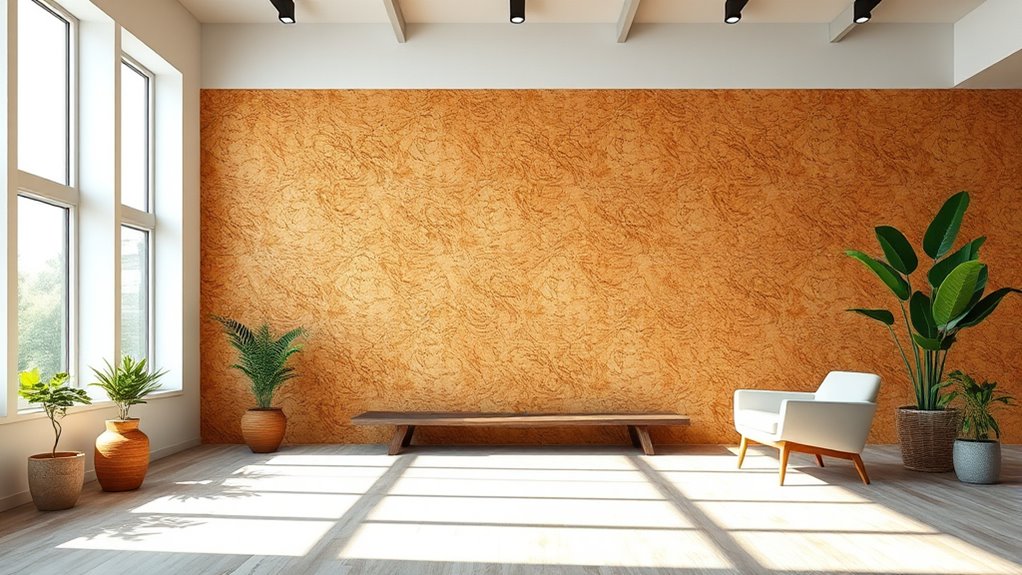
Are you curious about how cork wall panels perform in real-world settings? You’ll find that cork has proven its worth across diverse environments. For example, the Google store in New York features award-winning cork walls that highlight both style and sustainability. Residential spaces use cork tiles to boost acoustic comfort and warmth, showing its practicality. In offices, cork panels provide superior soundproofing and energy savings, improving work environments. Boutique hotels adopt cork coverings to craft eco-conscious, inviting interiors that attract eco-minded guests. Lastly, case studies reveal that cork implementations often earn extra LEED points and positive environmental assessments.
- Award-winning eco-friendly designs
- Improved acoustics and warmth in homes
- Enhanced soundproofing and energy efficiency in offices
- Unique, sustainable hotel interiors
- Increased green building certifications
Future Trends and Market Potential of Cork in Green Design
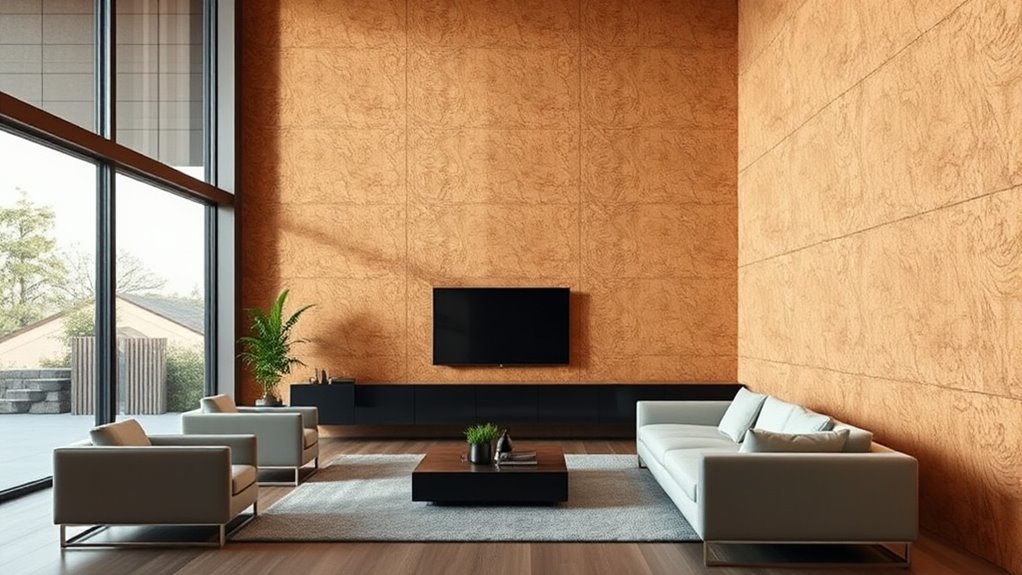
Given the increasing focus on sustainable building practices, cork wall panels are poised to play a pivotal role in the future of green design. The global eco-friendly building materials market is expected to grow rapidly, with cork leading as a sustainable interior option. Advances in manufacturing now allow cork to offer diverse aesthetics, fitting modern, biophilic, and design-forward spaces. Rising environmental regulations and standards like LEED further boost demand for renewable, biodegradable materials such as cork. Consumers are also increasingly drawn to natural, hypoallergenic, and fire-retardant finishes, expanding market potential. Industry forecasts predict faster adoption of cork wall panels as part of broader trends toward carbon-negative and regenerative architecture, making cork an integral component in future green building innovations.
Frequently Asked Questions
Is Cork Flooring a Good Green Design Alternative?
Cork flooring is a smart green design choice because it’s sustainable, renewable, and eco-friendly. You benefit from its excellent insulation, which can lower energy bills, and it’s hypoallergenic, promoting healthier indoor air. Plus, it’s durable, requires little maintenance, and is biodegradable and recyclable. By choosing cork, you support environmentally conscious living, reduce your carbon footprint, and create a comfortable, stylish space that aligns with sustainable values.
Is Cork Board Eco-Friendly?
You might wonder if cork board truly lives up to its eco-friendly reputation. The answer is a confident yes. Made from bark that’s harvested sustainably, cork is renewable, biodegradable, and recyclable. Its production creates minimal waste and actually helps trees absorb more CO2. When you choose certified cork, you’re supporting responsible forestry that promotes biodiversity. So, yes—cork board isn’t just stylish; it’s a smart, green choice for your space.
Is Cork Flooring Making a Comeback?
Cork flooring is definitely making a comeback, and you should consider it for your space. Its eco-friendly qualities, like being renewable and biodegradable, appeal to your sustainable values. Plus, its excellent insulation keeps your home comfortable and energy-efficient. Modern finishes let you mimic more expensive materials, and its durability means low maintenance. So, if you want stylish, eco-conscious flooring, cork is an excellent choice that’s gaining popularity again.
What Is One Downside of Cork Flooring?
Did you know cork flooring can fade by up to 20% in just a few years when exposed to direct sunlight? One downside is its susceptibility to fading over time, especially in sunny areas. You might find that your cork floors lose their vibrant look and need extra care, like window treatments, to prevent sun damage. This vulnerability can make cork less ideal if sunlight exposure isn’t well-managed.
Conclusion
Embracing cork wall panels means you’re making a smart, eco-friendly choice that benefits both your space and the planet. With their versatility, sustainability, and innovative features, cork walls are shaping the future of green décor. Remember, a wise person once said, “The best time to plant a tree was 20 years ago; the second best time is now.” So, why not start your eco-conscious design journey today?
